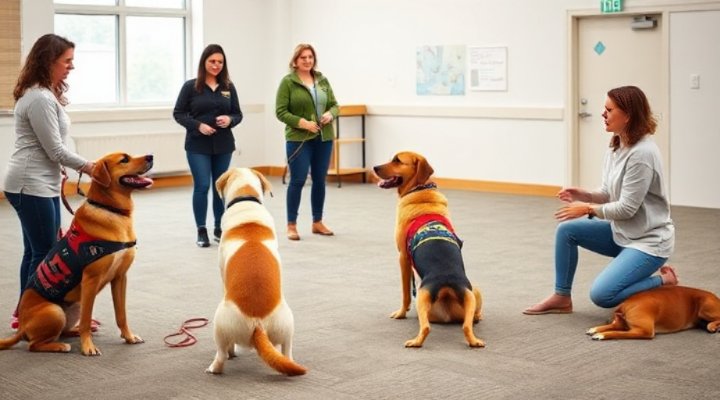Dog training is more than just teaching tricks—it’s about building a lifelong bond with your furry companion. Whether you’re dealing with a rambunctious puppy or an older dog with established habits, proper training can transform your relationship. Above all, remember that patience and consistency are key to successful dog training.

The Fundamentals of Dog Training
Before diving into complex commands, it’s crucial to master the basics. Firstly, establish clear communication with your dog. Simple commands like ‘sit’, ‘stay’, and ‘come’ form the foundation of all dog training. For example, when teaching ‘sit’, hold a treat near your dog’s nose and slowly move it upward. As their head follows the treat, their bottom will naturally lower to the ground.
Meanwhile, positive reinforcement should be your primary training method. According to the American Veterinary Medical Association, reward-based training strengthens the human-animal bond while effectively modifying behavior. That is to say, always have tasty treats and enthusiastic praise ready for successful attempts.

Common Puppy Training Challenges
Puppy training comes with its own set of challenges. For instance, biting and chewing are natural behaviors that need gentle redirection. When my Labrador, Max, was a puppy, he went through a phase of chewing everything in sight. The solution? Providing plenty of appropriate chew toys and consistently redirecting him when he chose the wrong item.
Housebreaking is another critical aspect of puppy training. Establish a regular schedule for bathroom breaks—after waking up, after meals, and before bedtime. Subsequently, praise your puppy enthusiastically when they eliminate in the correct spot. If accidents happen (and they will), clean thoroughly to remove odors that might attract repeat offenses.
Intermediate Dog Training Techniques
Once your dog has mastered basic commands, you can progress to more challenging exercises. Loose leash walking, for instance, makes walks more enjoyable for both of you. Start in a low-distraction environment, rewarding your dog for staying by your side. Gradually increase the difficulty as their skills improve.
Furthermore, teaching your dog to ‘leave it’ can prevent them from picking up dangerous items. Begin with a treat in your closed hand, only opening it when your dog stops trying to get it. Eventually, you can practice with items on the ground. This command could literally save your dog’s life one day.

Advanced Training for Skilled Dogs
For dogs that excel at basic and intermediate training, advanced techniques offer mental stimulation and physical challenge. Agility training, for example, combines obedience with athleticism. You don’t need fancy equipment to start—simple jumps made from broomsticks or tunnels created from chairs and blankets can begin the process.
Similarly, trick training keeps your dog’s mind sharp. From rolling over to playing dead, these fun exercises reinforce your bond. My neighbor’s poodle learned to ‘say prayers’ by putting her paws on a stool and bowing her head—it’s adorable and shows what patient training can achieve.
Behavioral Problem Solving
Even well-trained dogs can develop behavioral issues. Separation anxiety, excessive barking, or leash reactivity require specialized approaches. Importantly, never punish fear-based behaviors—this only makes the problem worse. Instead, use desensitization techniques to gradually acclimate your dog to triggering situations.
For severe behavioral issues, consider consulting a professional. Our guide on finding a dog behaviorist near you can help locate qualified assistance. Remember, there’s no shame in seeking help—it shows your commitment to your dog’s wellbeing.

Training for Different Life Stages
Puppies aren’t the only dogs that benefit from training. Adult dogs can learn new tricks, and senior dogs need mental stimulation to stay sharp. The key is adjusting your expectations and methods based on your dog’s age and physical capabilities.
For older dogs, shorter training sessions with more frequent breaks work best. Focus on maintaining existing skills rather than demanding perfect precision. Meanwhile, adolescent dogs (6-18 months) often test boundaries—consistent reinforcement of rules during this phase prevents future problems.
Creating a Training Routine
Consistency is the golden rule of dog training. Establish a daily routine that includes short, focused sessions. Five to ten minutes several times a day is more effective than one long session that leaves both of you frustrated.
Additionally, incorporate training into everyday activities. Ask for a ‘sit’ before meals, practice ‘stay’ when opening doors, or work on recall during playtime. This approach, known as ‘life rewards’, makes training a natural part of your dog’s day rather than a separate chore.

The Role of Nutrition in Training
Don’t overlook the importance of proper nutrition in your training regimen. A well-fed dog with balanced energy levels will be more receptive to learning. Check out our article on choosing the best dog food for guidance on optimal nutrition.
Training treats should be small, soft, and highly appealing to your dog. Reserve special treats just for training to maintain their value. You can even use portions of your dog’s regular meals as rewards during training sessions.
Final Thoughts on Dog Training Success
Dog training is a journey, not a destination. Even after mastering advanced techniques, regular practice maintains skills and strengthens your bond. Most importantly, make training fun for both of you—if you’re not enjoying the process, your dog won’t either.
For those considering professional help, our guide on choosing a dog training center offers valuable tips. Remember, every dog learns at their own pace. Celebrate small victories and be patient with setbacks.
Related Keywords: puppy training, dog obedience, advanced dog training, dog behavior modification, positive reinforcement training, agility training, dog tricks, behavioral training

